The museum guide in Lucca suggests that I pick up the loaded rucksack from the bucket, carry it to the other end of the room and put it back in the bucket. Some sort of gadget inside will calculate how long it would take me to walk from Canterbury to Rome along the Via Francigena.
“It will take you 93 days, at 17km a day,” the display reads as I put it down. Three months. I am not planning on walking the whole way, and will only be carrying a daysack. However, it is 30 degrees outside, and there will be little shade. I am setting out on the Tuscan leg of the ancient pilgrim route with a group of Irish walkers, many of whom had already walked the Camino de Santiago. I wondered if I could keep up.
Before we left I ventured into the fabulously frescoed Basilica of San Frediano, named after an Irish monk who walked to Rome in the sixth century. He later settled in Lucca and became a bishop. In a side chapel nearby are the relics of San Silao. “He’s Irish as well,” said the church attendant. “We haven’t had him very long. The convent he was in was closing down, so they sent him here.”
Relics, monasteries and churches are scattered all along the Via Francigena, which was the religious highway of the Middle Ages, crossing Britain, France, Switzerland and Italy before reaching Rome. The route, recently revived, is based on the journal written by Sigeric, archbishop of Canterbury, on his way back from visiting the pope in AD 990.
We take to the trail near the hilltop town of San Miniato, walking through a classic Tuscan landscape, quilted green and gold by wheatfields and olive groves. Long avenues of cypresses lead to sturdy square Tuscan manor houses surrounded by vines. The path twists and turns with the folds of the hills, skirting vineyards and in one case taking us through someone's front garden while a woman dozes on the terrace.
Within minutes of leaving the asphalt road, I find myself falling into a rhythm. Within an hour the only issue is when we will find the next patch of shade, to draw breath and escape the sweltering heat, if only for a moment. There are water fountains at intervals and the route is well marked. The only task is to put one foot in front of the other and to get up in the morning and do it all over again.
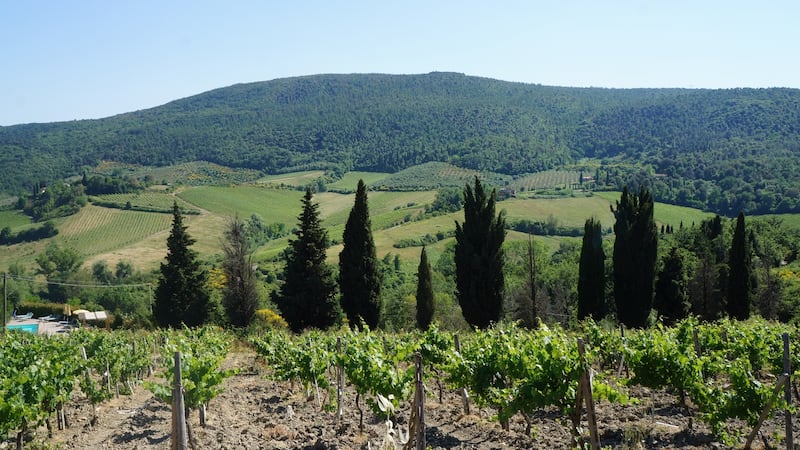
On the second day I have a few twinges in my calves as we walk downhill out of Gambassi Terme, passing a sign indicating the distance to Rome: 279km. It also helpfully informs me that it is 842km to Brindisi, for those continuing to Jerusalem, and 1,426km to Canterbury, for anyone determined enough to walk back.
After pizzas from a wood-fired oven at a rural restaurant, we struggle in 30-degree heat towards the Pieve del Colle. Our climb is rewarded with stunning views and a welcome rest in the cool surroundings of a Romanesque church of exquisite simplicity. We also get our first glimpse of the hilltop town of San Gimignano, its 14 towers piercing a sapphire sky.
Ringing the bell
At the 11th century Monastero di San Girolamo, I ring the bell, as thousands of pilgrims must have done before me. There is no answer, and I wondered if the Benedictine nuns are at prayer, but two passing pellegrini point their walking sticks down the street, where a nun in a black habit is waving goodbye from another door. Sr Maddalena is a member of a closed order but seems remarkably happy to chat.
“The 53rd rule of St Benedict obliges us to have a house for guests,” she says, as we climb to the dormitories on the second floor. “Nowadays it is also how we survive.” Pilgrims pay €25 a night to stay in three- or four-bed en suite rooms and have access to the monastery’s private garden.
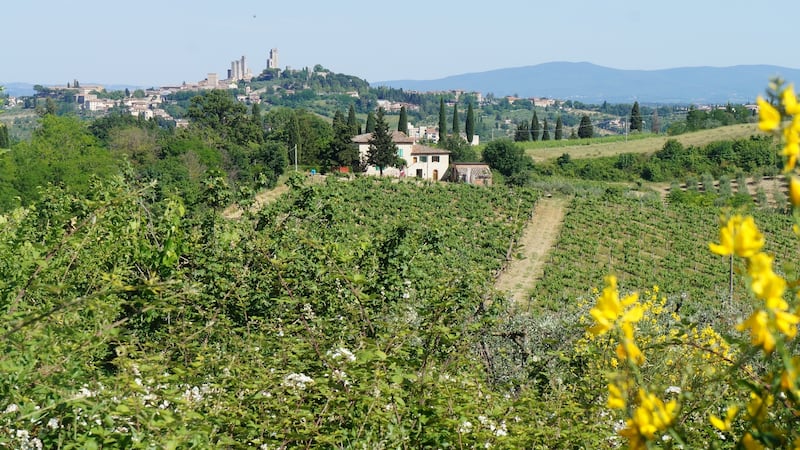
From somewhere in the cloister a bell peals, calling Sr Maddalena to prayer. This is private time, but I am welcome to join them later at Vespers or Compline, she says, though few people do nowadays. After she leaves, I sit for a while, letting the silence seep in. On the way out I read the last entry in the visitor’s book. “I found what I was searching for,” writes Juliette from France.
I wonder what that was, and what drives pilgrims in general to set out on a long and dangerous journey. Many pilgrims who walked in earlier times were seeking healing, hoping to save their souls, or at least reduce their time in Purgatory.
I couldn’t in all honesty describe myself as a pilgrim. Most of the time I feel like a walker crossing wonderful terrain, enjoying long conversations with my fellow travellers.
The next morning I have a brief glimpse of life as a lone pellegrino. We have stopped to have our credenziali – pilgrim passports – stamped at the church at San Marziale and I get chatting to the sacristan, who often allows pilgrims to sleep on the office floor. By the time I come out everyone has gone.
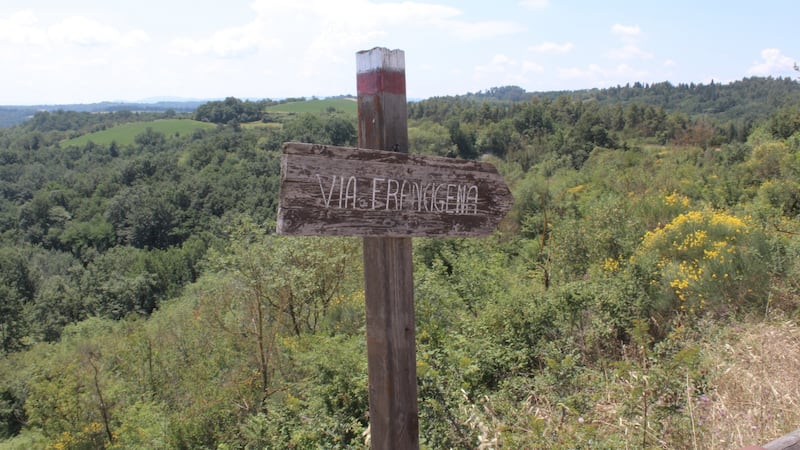
The sacristan points me towards the Via Francigena and I remind myself that the early pilgrims never knew what the day would bring. The red and white waymarks provide reassurance, and I walk in silence along the strada bianca for a few kilometres, noting every butterfly and flower; daisy-like camomile, fleur de lys, yellow broom. Wild mint scents my path and jasmine flowers hangs from occasional gardens. Marbled whites and exotic fritillaries dance, stopping to feed on the abundant wildflower verges that Tuscan farmers seem to leave at the edge of their fields. I feel extraordinarily light, even joyful.
Modern technology means my solitude does not last long. When there is no sign of the others I feel guilty they might be worried, and consult the Whatsapp group, to discover I have somehow passed them out. The spell is broken but camaraderie restored.
Last day
On our last day we set out from the fairy-tale fortress of Monteriggioni, built by the Sienese to protect them from Florence. Along the way I fall into step with two pellegrini walking to Rome. Nikola from Serbia and Oliver from Switzerland tell me they sometimes walk together or meet up in the evenings.
“I’ve heard people say walking this will transform your life,” says Nikola. “I’m still waiting for that to happen, but what I’ve learned is that you can live with very little.”
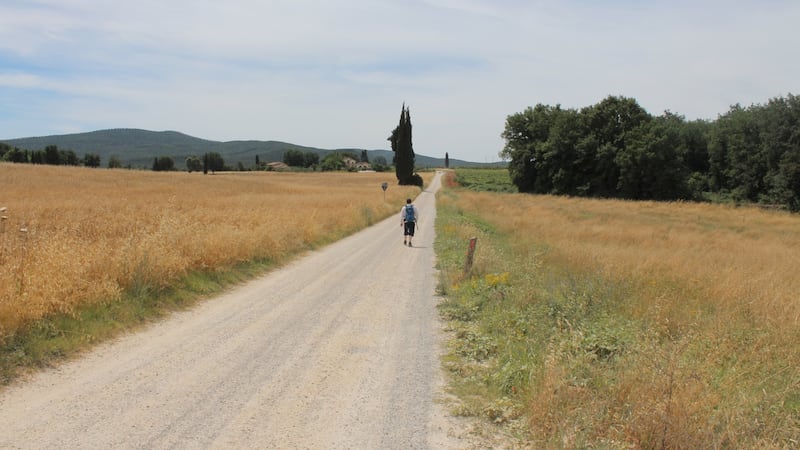
Oliver is nursing the results of his blistering pace of 30km a day. “You have a lot of little pains, but you always have to get up and go on,” he says. “It’s a good lesson for your life.”
Later we hear the tell-tale clap of thunder. We still have eight kilometres to go to reach Siena. The rain reaches us and the thunder and lighting grow closer together, forks shattering the sky. As the deluge begins we race for the shelter of a stone arch. Our guide, Anna, is worried, and the decision is taken to abandon the trail, so instead of walking proudly through Siena's gates, our bedraggled group reaches the city by taxi.
Through the blisters and the bites, the sore calves and the soaking, we have bonded as a group. In true Irish style the slagging has been mighty, but life stories have been told too, and confidences shared, over long dinners and jugs of red wine.
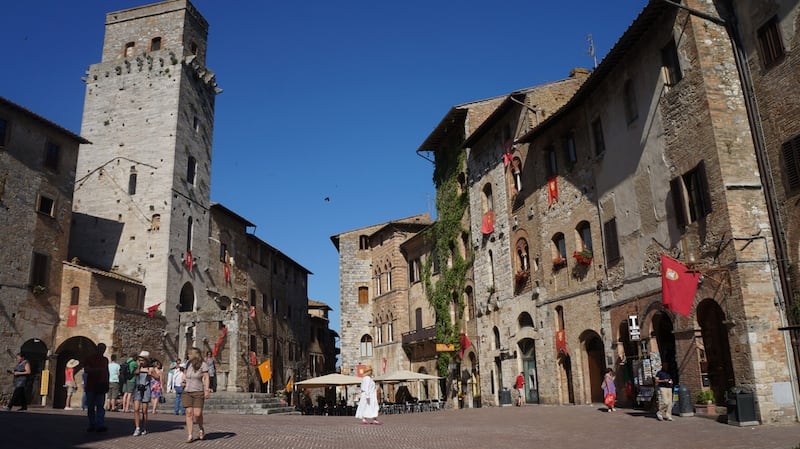
At the Duomo – Siena’s black and white striped cathedral – I get my final pilgrim’s stamp and slip into a side chapel. I light a candle and make my way to the Campo, the great scallop-shell-shaped piazza at the centre of city life. I sip a glass of Vernaccia di San Gimignano and watch tourists on their own pilgrimages, the selfie replacing the stamped pilgrim’s passport as proof of the journey.
From here, all roads lead to Rome. While the Irish monk San Frediano never went home, the modern pilgrim can always return and pick up the journey again. There would be no daily decisions to make. All I would have to do is put one foot in front of the other.
Margaret Ward travelled as a guest of Camino Ways, caminoways.com
HOW TO DO IT: VIA FRANCIGENA
Aer Lingus and Ryanair fly from Dublin to Pisa
Trains and buses to various starting points
trenitalia.it
sitabus.it
Camino Ways offers a number of group departures each year with a six-night tour starting from €680pps. They also offer week-long self-guided trips from Lucca to Siena (flexible dates), including accommodation in three-star hotels, breakfast and dinner, walking notes and luggage transfers from €835pps. Upgrades available. Flights not included. caminoways.com
Those operating independently can book luggage transfers with bags-free.com
Pilgrims with a credenziali or "passports" can stay at a network of monasteries and convents in shared rooms/dormitories for about €20 per night. There are also many hotels and agriturismos along the route.
viafrancigena.eu is the main source of information. There is also an app, though using GPS except in an emergency may take from the experience. There is also a cycling route.
The Via Francigena Guidebook 2 (The Great St Bernard Pass to Rome) by Alison Raju (Cicerone)
TIPS
Always start the day with a litre of water and fill up any time you see a fountain. While some stretches, such as San Miniato to Gambassi Terme (28 km), have no other services, most stages in Tuscany are shorter (15-20 km) and have a bar or cafe en route.
Walking shoes are fine. Boots are not needed.
Bring walking sticks, if you are used to them, along with a rain jacket, sunhat and sunscreen, Compeed (for blisters) plasters and insect repellent. If you are walking unsupported, be ruthless about what you carry.











